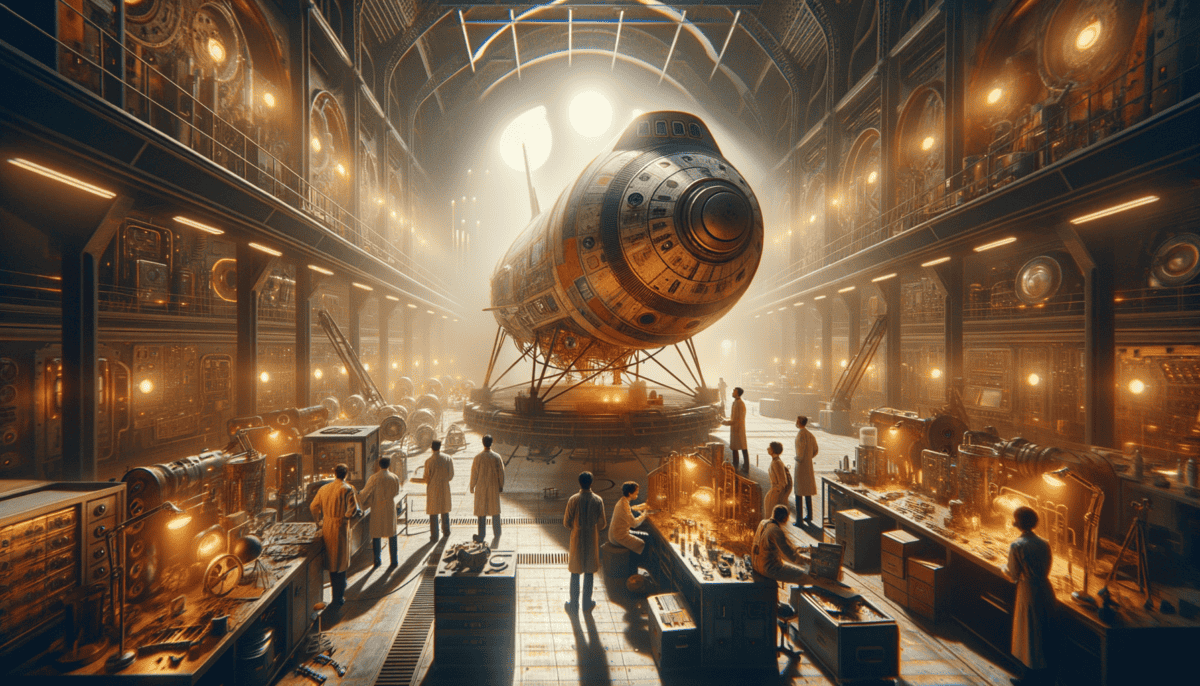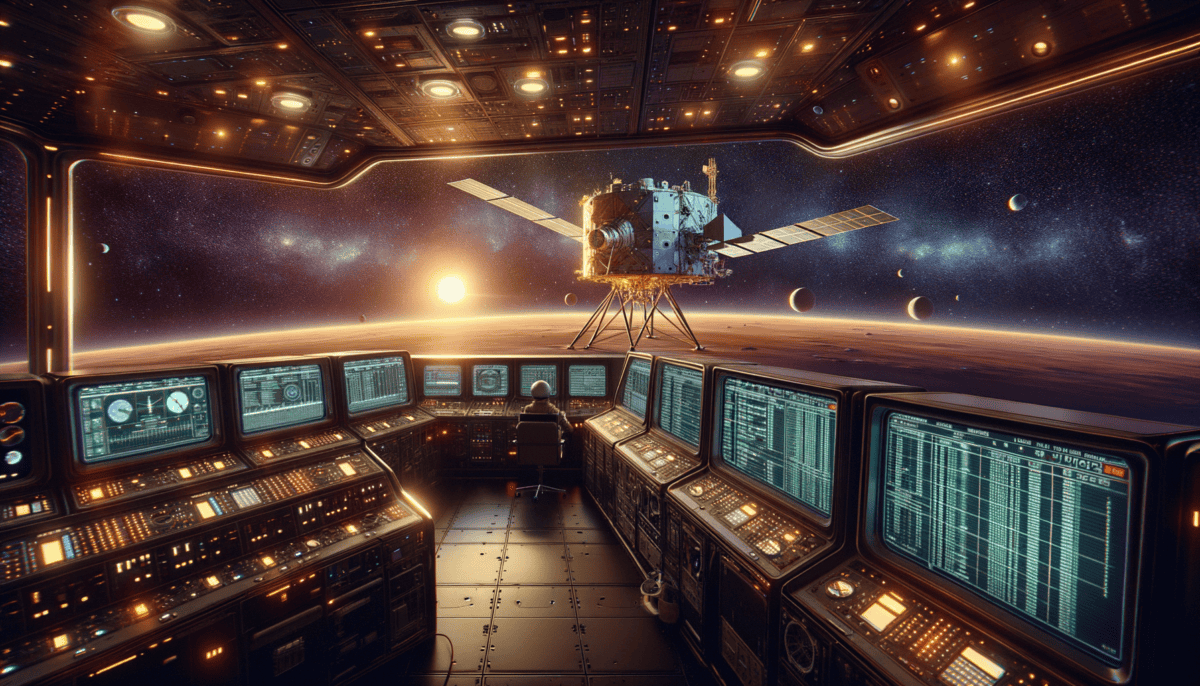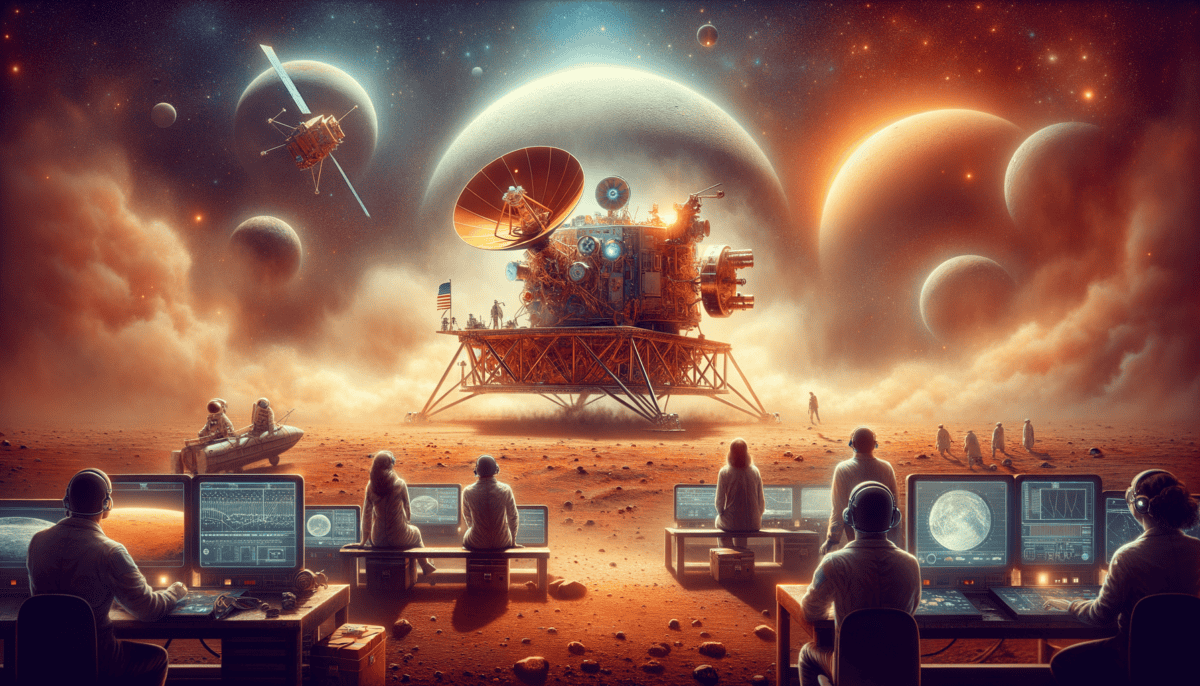The Dream Takes Flight
In 1975, a group of brave scientists at NASA had a big dream. They wanted to send special robots to Mars! These robots would be the first to take pictures and study the red planet up close.
“What if we could learn if there’s life on Mars?” asked Dr. Carl Sagan, one of the smartest space scientists. His eyes lit up whenever he talked about exploring other planets.
The team worked in a big building called NASA’s Jet Propulsion Laboratory. It was like a giant workshop where scientists built space robots. Everyone was excited but also a little nervous.
“We’ve never sent anything this far into space before,” said mission director Jim Martin. He was like the team’s coach, making sure everyone worked together.
The Big Plan
The scientists made a list of what they wanted their Mars robots to do:
- Take clear pictures of Mars’s surface
- Check if there are tiny living things in Mars’s soil
- Study the weather on Mars
- Look for water that might be hidden underground
Dr. Gerald Soffen, the chief scientist, walked through the busy halls. “Every day we work on this project brings us closer to understanding our solar system,” he told his team with a smile.
“This mission will change how we see our place in space forever.” – Dr. Gerald Soffen
Getting Ready for the Big Journey
Building these special Mars robots wasn’t easy. The team faced many challenges:
Problem #1: Mars is very cold and has big dust storms
Solution: They made the robots extra strong and gave them special blankets to stay warm
Problem #2: It takes a very long time to send messages to Mars
Solution: They gave the robots smart computers to make some decisions by themselves
Young engineer Sarah Thompson looked at the robots being built. “These machines will be our eyes and hands on Mars,” she said. “They’ll help us solve some of space’s biggest mysteries!”
The team named their robots Viking 1 and Viking 2. These weren’t ordinary robots – they were like brave explorers getting ready to visit a new world that no one had ever touched before.
As the sun set over the laboratory each evening, the team worked harder and harder. They knew they were part of something special. Something that would help humans learn more about the mysterious red planet that had fascinated people for hundreds of years.
The countdown to launch day was getting closer. Everyone could feel the excitement building. Soon, their dreams of exploring Mars would become real!
Building the Impossible
The morning sun streamed through the windows of NASA’s giant workshop. Engineers rushed around with tools and blueprints. They were building something amazing – two spacecraft called Viking 1 and Viking 2!
“It’s like building the biggest and most special toy ever,” said Mike Thompson, one of the lead engineers. He smiled as he looked at the shiny parts spread out on his workbench.
Special Parts for a Special Mission
Each Viking spacecraft needed lots of cool gadgets to work on Mars:
- Special cameras to take pictures
- Strong arms to grab Mars rocks
- Smart computers to think and make decisions
- Big solar panels to get power from the sun
- Strong wheels to drive on Mars’s bumpy ground
“We’re not just building machines – we’re building explorers that will be our friends on Mars!” – Sarah Chen, Robot Designer
Solving Big Problems
The team faced new challenges every day. But they were good at finding clever solutions!
Challenge #1: Mars dust could get inside the machines
Solution: They made special covers like tiny umbrellas to protect the parts
Challenge #2: The spacecraft needed to land softly on Mars
Solution: They added special cushions like giant pillows to help it land gently
“Look at this!” called out Jenny Rodriguez, showing her friends a tiny computer chip. “This will help Viking think and make decisions all by itself when it’s on Mars!”
Testing, Testing, 1-2-3!
Before sending the Vikings to Mars, the team had to make sure everything worked perfectly. They built a special room that looked just like Mars!
“We call it our Mars playground,” laughed Tom Baker, the test leader. “We can make it super cold and dusty, just like the real Mars.”
The team tested everything again and again. They wanted to make sure their space explorers were ready for their big adventure.
Dr. Maria Santos watched as Viking 1 moved its arm in the test room. “Each part we build is like a piece of a big puzzle,” she said. “When all the pieces fit together perfectly, we’ll be ready for Mars!”
Almost Ready for Launch
After months of hard work, Viking 1 and Viking 2 were almost finished. They stood tall and proud in the workshop, covered in gold foil that sparkled like stars. ⭐
“They’re beautiful,” whispered Bobby Chen, the youngest engineer on the team. “I can’t believe we built something that’s going to Mars!”
The whole team gathered around their creation. Soon, these amazing machines would begin their long journey to the red planet. The impossible dream was becoming real!
The countdown clock on the wall kept ticking. Launch day was getting closer and closer. The Vikings were ready for their biggest adventure ever!
The Big Day Arrives
The sky was still dark when hundreds of people rushed to Cape Canaveral. Today was special – Viking 1 was ready to blast off to Mars!
“Everything must be perfect,” said Flight Director Jane Wilson. She looked at all the blinking lights on her control panel. The room buzzed with excitement. ✨
Getting Ready for Launch
The morning was busy with last-minute checks:
- Weather watchers checked the sky
- Engineers tested the rocket engines
- Computer experts checked all systems
- Safety team made sure everyone was ready
- Radio team prepared to talk to Viking
“T-minus 60 minutes!” called out the launch announcer. Everyone sat up straighter in their chairs.
“This is like sending our child to college – except our child is going to Mars!” – Dr. Tom Baker, Lead Engineer
The Countdown Begins
The giant clock on the wall showed 10 minutes until launch. The room got very quiet.
“10… 9… 8…” Everyone held their breath.
“7… 6… 5…” The rocket engines started to rumble.
“4… 3… 2…” Smoke filled the launch pad.
“1… LIFTOFF!”
The ground shook as the mighty rocket pushed Viking 1 toward space. Bright flames shot out from the bottom of the rocket. It was like a giant candle lighting up the morning sky!
Up, Up, and Away!
“Look at it go!” shouted Bobby Chen. The rocket climbed higher and higher, leaving a trail of white smoke behind. ☁️
Viking 1 had to go really fast – about 25,000 miles per hour – to escape Earth’s gravity and reach Mars!
The control room erupted in cheers when Viking 1 safely separated from its rocket. Now it was floating freely in space, ready to begin its long journey.
First Steps of a Long Journey
“Hello, Viking 1, can you hear us?” called Maria through the radio. Seconds later, beeping sounds came back. Viking 1 was talking to them!
“All systems are working perfectly,” announced Tom. “Our Viking is healthy and happy in space!”
A Second Viking Joins the Adventure
A few weeks later, Viking 2 also blasted off into space. Now both spacecraft were on their way to Mars!
“Our Vikings are like brave explorers,” said Jenny Rodriguez. “They’re going farther than any NASA spacecraft has ever gone before!”
As the team watched their screens, tiny dots showed where Viking 1 and Viking 2 were flying through space. The greatest adventure in space history had begun!
“Sweet dreams, brave Vikings,” whispered Sarah Chen. “See you at Mars!” ➡️
Journey Through the Stars
Day after day, Viking 1 and Viking 2 sailed through the dark ocean of space. The spacecraft were like tiny boats in a huge black sea of stars. ⭐
Life in Mission Control
“Good morning, Vikings!” Sarah would say every day when she came to work. The control room was always busy with people watching over their space travelers. ️
Dr. Tom checked his computer screen. “Viking 1 is sending us pictures of stars today!” Everyone gathered around to look. The pictures helped them make sure Viking was going the right way.
“It’s like following a map in space, but our map is made of stars!” – Dr. Sarah Chen
Keeping the Vikings Happy
The team had special jobs to do:
- Check if solar panels were getting enough sunlight
- Make sure the computers were working
- Listen for radio signals
- Watch the temperature
- Plan course corrections
“Sometimes we need to wake Viking up to make small turns,” explained Maria. “Just like when you adjust your bicycle to stay on the sidewalk!”
Space Science Games
The Vikings weren’t just flying to Mars – they were doing science too! They took pictures of stars and planets along the way.
“Look!” Bobby pointed to his screen one day. “Viking 2 can see Jupiter!” The giant planet looked like a bright marble in space.
Solving Space Puzzles
Sometimes the Vikings had small problems. One day, Viking 1’s radio got quiet.
“Don’t worry,” said Jenny. “It’s just space dust making static. Like when your TV gets fuzzy during a storm.”
The team sent special commands to clean Viking’s radio antenna. Soon it was talking clearly again!
Getting Close to Mars
After many months, exciting news came. “I can see Mars!” shouted Tom. “It’s getting bigger in Viking’s cameras!”
The red planet looked like a tiny red dot at first. But every day, it grew larger. The Vikings were almost there!
Ready for the Big Moment
“Time to get ready for the hardest part,” said Flight Director Wilson. “Landing on Mars!”
The team started practicing for landing day. They wanted everything to be perfect when their brave Vikings finally reached the red planet.
“Mars, here we come!” the whole team cheered. The greatest part of their space adventure was about to begin!
Touchdown on the Red Planet
The big day finally came! Viking 1 was ready to land on Mars. Everyone in Mission Control held their breath.
The Seven Minutes of Wonder
“Viking 1 is starting to enter Mars’ sky!” announced Dr. Sarah. The spacecraft had to slow down from very fast to very slow in just seven minutes.
The room was super quiet. You could hear everyone’s hearts beating fast.
“It’s like throwing a paper airplane, but millions of miles away in space!” – Flight Director Wilson
Landing Steps
The team watched as Viking 1:
- Used its heat shield to slow down
- Opened its big parachute
- Turned on landing rockets
- Looked for a safe spot
- Touched the ground softly
First Pictures from Mars
“We got it!” shouted Bobby. “Viking 1 is safe on Mars!”
The first picture came through. It showed Viking’s foot on Mars! The ground looked red and rocky, like a giant desert.
Making New Friends
Viking 1 started doing its science jobs right away. It had special tools to:
✨ Take pictures of the red rocks
✨ Feel how hot or cold it was
✨ Look at Mars’ air
✨ Dig in the ground
Surprise on Mars!
“Look at this!” Maria pointed to a new picture. “The sunset on Mars is blue!”
On Earth, sunsets are red and orange. But on Mars, they look blue because of the special dust in Mars’ air.
Viking 2’s Turn
A few weeks later, Viking 2 also landed on Mars! Now Earth had two robot friends on the red planet.
“Two Vikings are better than one!” laughed Jenny. “They can tell us twice as much about Mars!”
Hard Work on Mars
Both Vikings worked very hard. They dug holes in the ground and took lots of pictures. Sometimes they found weird things!
Messages from Mars
Every day, the Vikings sent new pictures and information back to Earth. The team was so excited to learn about their new neighbor planet.
“Mars is like a whole new world waiting for us to explore,” said Dr. Tom. “And our Vikings are the first to tell us its stories!” ⭐
Legacy of the Vikings
The Viking missions changed how we see Mars forever! Let’s see what these brave space robots taught us.
Amazing Mars Facts
“These Vikings were super smart!” said Dr. Sarah, looking at all the pictures on her desk. “They showed us so many cool things about Mars!”
What We Learned
The Vikings helped us understand Mars better than ever before. Here’s what they found:
- Mars has very cold weather
- The ground has lots of iron, making it red
- Big dust storms happen often
- Mars once had lots of water
- The air is very thin
Making History
“Remember when we first landed?” Bobby asked. “Now look at all we know!”
“The Vikings were like brave explorers who went to a new land and sent back postcards to tell us all about it!” – Dr. Jenny
Inspiring New Dreams
Many kids who watched the Viking missions grew up to be space scientists! They wanted to explore Mars too!
“The Vikings showed us that we can do amazing things,” said Maria. “They made us dream bigger!”
New Adventures Begin
The Vikings worked on Mars for many years. They were strong and brave. Because of them, NASA sent more robots to Mars:
Spirit and Opportunity
Curiosity
Perseverance
Looking to the Future
One day, humans might visit Mars! The Vikings helped make this dream possible.
“The Vikings were just the beginning,” smiled Dr. Tom. “Now we know Mars better, and we can plan even bigger adventures!” ⭐
A Special Thank You
The Viking team had one last meeting. They put up a big picture of both Vikings on Mars.
“Thank you, brave Vikings,” they all said together. “You taught us so much about the red planet!” ❤️
The Viking Program showed us that with big dreams and hard work, we can reach for the stars. And sometimes, we can even touch them!
Every time we look up at the red dot in the night sky, we can remember our Viking friends who helped us know Mars better. They opened the door to a whole new world of space exploration. Who knows what we’ll discover next? ✨






